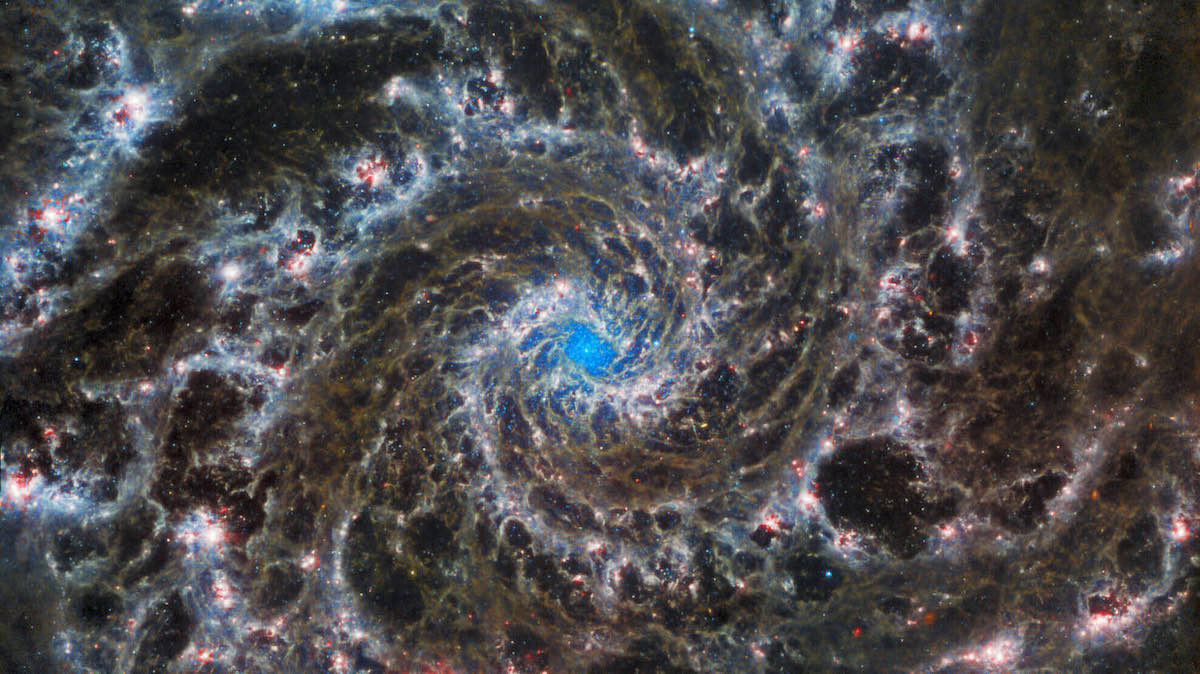
Fresh images from the James Webb Space Telescope show the Phantom Galaxy in vibrant infrared light, part of a series of observations with the new $10 billion observatory to help astronomers study the formation of stars.
The Phantom Galaxy, also known as Messier 74, is 32 million light-years from Earth. Astronomers have previously studied the spiral galaxy with ground-based observatories and the Hubble Space Telescope. Now Webb is adding its unmatched vision to resolve previously unseen features of the galaxy.
Webb’s observations will allow astronomers to pinpoint star-forming regions of the galaxy, according to the European Space Agency. The Mid-Infrared Instrument, or MIRI, camera that made the observations of the Phantom Galaxy was part of ESA’s contribution to the Webb mission, a joint project with NASA and the Canadian Space Agency.
The MIRI data will help scientists accurately measure the masses and ages of star clusters, and gain insights into the small grains of dust drifting in interstellar space between the stars, according to ESA.
Hubble’s observations of the Phantom Galaxy revealed bright areas of star formation in ultraviolet and visible wavelengths. Webb resolved the same star-forming regions in its infrared observations.
“By combining data from telescopes operating across the electromagnetic spectrum, scientists can gain greater insight into astronomical objects than by using a single observatory – even one as powerful as Webb!” ESA said in a press release.

The Phantom Galaxy is positioned face-on to Earth. It is located in the constellation Pisces, and features well-defined spiral arms. Webb’s view of the Phantom Galaxy shows bright star-forming dust clouds strung around the spiral arms, and a blue glow from the dense star cluster at the core of the galaxy.
The James Webb Space Telescope launched Dec. 25 on a European Ariane 5 rocket, deployed solar arrays, unfurled tennis court-sized sunshield, and unfolded a 21.3-foot-wide (6.5-meter) primary mirror, and arrived in its operational orbit around a million miles (1.5 million kilometers) from Earth in January. Managers declared Webb operational July 12.
The $10 billion observatory is the largest space telescope ever built. Officials released the first science images from Webb in July, showing distant galaxies and dramatic views of a star-forming nebula. In August, officials released Webb’s first science observations of Jupiter as part of the mission’s Early Release Science program.
Webb carries four science instruments sensitive to the faint light from the distant universe. MIRI and the Near Infrared Spectrometer were developed in Europe, the Near Infrared Camera comes from the United States, and the Near-Infrared Imager and Slitless Spectrograph/Fine Guidance Sensor was provided by Canada.
Aside from helping astronomers study the formation of stars, Webb is designed to peer back in time to see the first galaxies that formed in the universe some 13.6 billion years ago, 200 million years after the Big Bang. The telescope will also observe planets around other stars, revealing the chemical composition of their atmospheres, and helping astronomers identify which worlds might be habitable.
Email the author.
Follow Stephen Clark on Twitter: @StephenClark1.
from Spaceflight Now https://ift.tt/U6Lm9aC
via World Space Info







0 comments:
Post a Comment